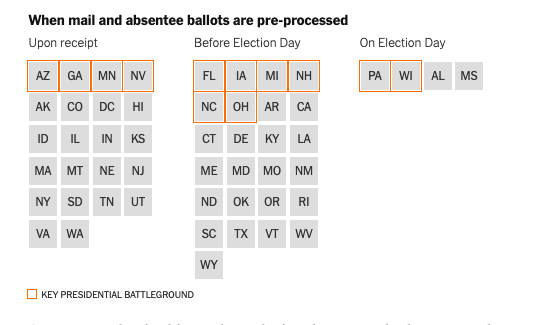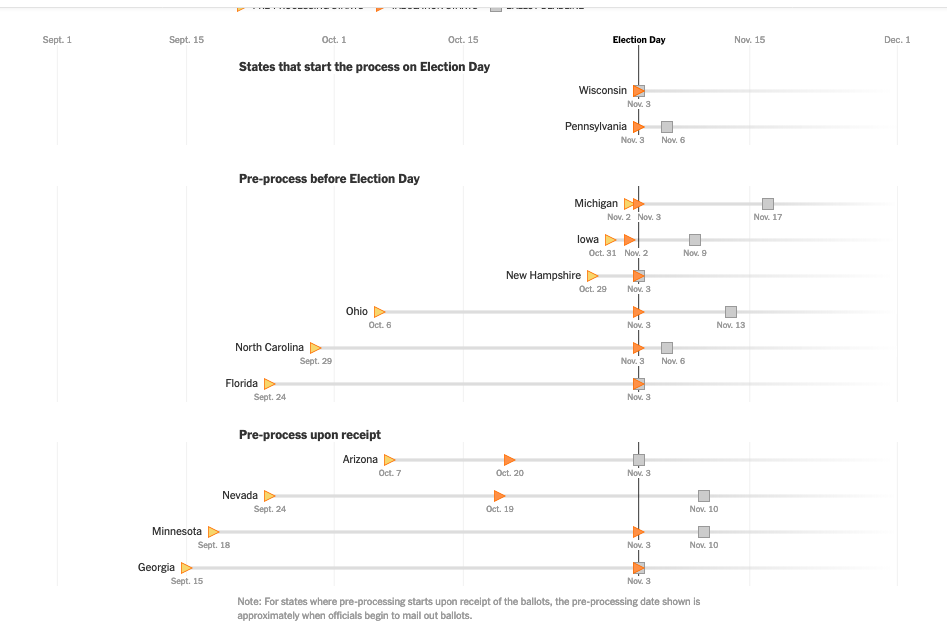It bears repeating and referencing when voting starts, when ballots will be considered valid (if they can be accepted past the Nov 3rd date) and what the interval is between mailing-in ballots
if you plan on using USPS or dropping them off at the polling station.
I am aware of a LOT of ramping up for getting Poll workers, and while it might not be considered a healthy choice for many, there are those who may want to check these resources out below.
If you know of anyone who is willing and able to go to the Polls to work, please refer to this website:
Encourage friends and family who are comfortable volunteering on election day in swing states (WI, MI, PA, NC, FL, AZ and NV, NH, GA, TX, OH, MN) Many locations workers can be 16+ and others 18+
You can take action from home or in person by serving as a nonpartisan Election Protection volunteer.
National Poll Worker Recruitment Day | U.S. Election Assistance Commission
Established by the U.S. Election Assistance Commission, National Poll Worker Recruitment Day is a day of action with the goal of encouraging potential poll workers to sign up to Help America Vote in 2020
Voting Early in Person
Starting in September, voters can visit a polling location or cast their absentee ballot in person in states that allow one or both methods. For many states, early voting rules vary by county, so check with local officials for details.
When in-person voting starts
Sept. 9 Alabama
Sept. 18 Minnesota, South Dakota, Virginia and Wyoming
Sept. 21 Vermont
Sept. 22 Missouri
Sept. 24 Illinois and Michigan
Oct. 2 Connecticut
Oct. 5 California, Iowa, Maine, Montana, Nebraska and South Carolina
Oct. 6 Indiana and Ohio
Oct. 7 Arizona
Oct. 10 New Hampshire
Oct. 12 Georgia
Oct. 13 Kentucky and Texas
Oct. 14 Kansas, Rhode Island and Tennessee
Oct. 15 North Carolina
Oct. 16 Washington
Oct. 17 Massachusetts, Nevada and New Mexico
Oct. 19 Alaska, Arkansas, Colorado , Idaho and North Dakota
Oct. 20 Hawaii, Louisiana, Utah and Wisconsin
Oct. 21 West Virginia
Oct. 24 Florida, Mississippi and New York
Oct. 26 Maryland
Oct. 27 District of Columbia
Oct. 29 OklahomaNotes: Pennsylvania did not make ballots available on Sept. 14 as expected. It’s unclear when ballots will sent out. New Jersey traditionally offers early voting, but because of the coronavirus pandemic, the state will be mailing ballots to all registered voters and making drop boxes avaialble. The only option to vote in person in New Jersey is on Election Day.
Voting by Mail
A majority of Americans will be eligible to vote by mail. Although many states have deadlines to request mail ballots less than two weeks before Election Day, the Postal Service recommends that voters request them by Oct. 19 to ensure that ballots are returned on time. Check with your county officials for more details.
Deadline to request a ballot
Oct. 9 Kentucky
Oct. 13 Rhode Island
Oct. 20 Maryland and New Mexico
Oct. 21 Missouri
Oct. 22 Indiana
Oct. 23 Arizona, Idaho, Nebraska, Texas and Virginia
Oct. 24 Alaska, Florida and Iowa
Oct. 27 Arkansas, Kansas, New York, North Carolina, Oklahoma, Pennsylvania and Tennessee
Oct. 28 Massachusetts and West Virginia
Oct. 29 Alabama, Illinois, Maine and Wisconsin
Oct. 30 Delaware, Georgia, Louisiana, Michigan and South Carolina
Oct. 31 Ohio
Nov. 2 Connecticut, Minnesota, Mississippi, Montana , New Hampshire, South Dakota and WyomingWhen ballots must be postmarked
Nov. 2 Alabama, Iowa, North Dakota, Ohio and Utah
Nov. 3 Alaska, California, District of Columbia, Georgia, Illinois, Kansas, Kentucky, Maryland, Massachusetts, Minnesota, Mississippi, Nevada, New Jersey, New York, North Carolina, Pennsylvania, Texas, Virginia, Washington, West Virginia and WisconsinWhen ballots must be received
The Postal Service recommends that voters allow seven days for a ballot to be returned via mail. If the state requires a ballot to arrive less than seven days after its postmark deadline, voters are advised to send it earlier.
Nov. 2 Louisiana and Vermont
Nov. 3 Alabama, Arizona, Arkansas, Colorado, Connecticut, Delaware, Florida, Hawaii, Idaho, Indiana, Maine, Michigan, Missouri, Montana, Nebraska, New Hampshire, New Mexico, Oklahoma, Oregon, Rhode Island, South Carolina, South Dakota, Tennessee and Wyoming
Nov. 4 Texas
Nov. 6 Georgia, Kansas, Kentucky, Massachusetts, North Carolina, Pennsylvania and Virginia
Nov. 9 Iowa, North Dakota, West Virginia and Wisconsin
Nov. 10 Minnesota, Mississippi, Nevada, New Jersey , New York and Utah
Nov. 13 Alaska, District of Columbia, Maryland and Ohio
Nov. 17 California
Nov. 18 Illinois
Nov. 23 WashingtonNotes: In Vermont, mail ballots must be returned to the town clerk’s office before the close of business the day before the election, or to the polling place by 7 p.m. on Election Day. Some counties in Utah will accept mail ballots up to Nov. 17. Mississippi and North Dakota do not have deadlines for requesting mail ballots. Because of an ongoing lawsuit, the deadlines to request and return a ballot in Wisconsin are subject to change.





